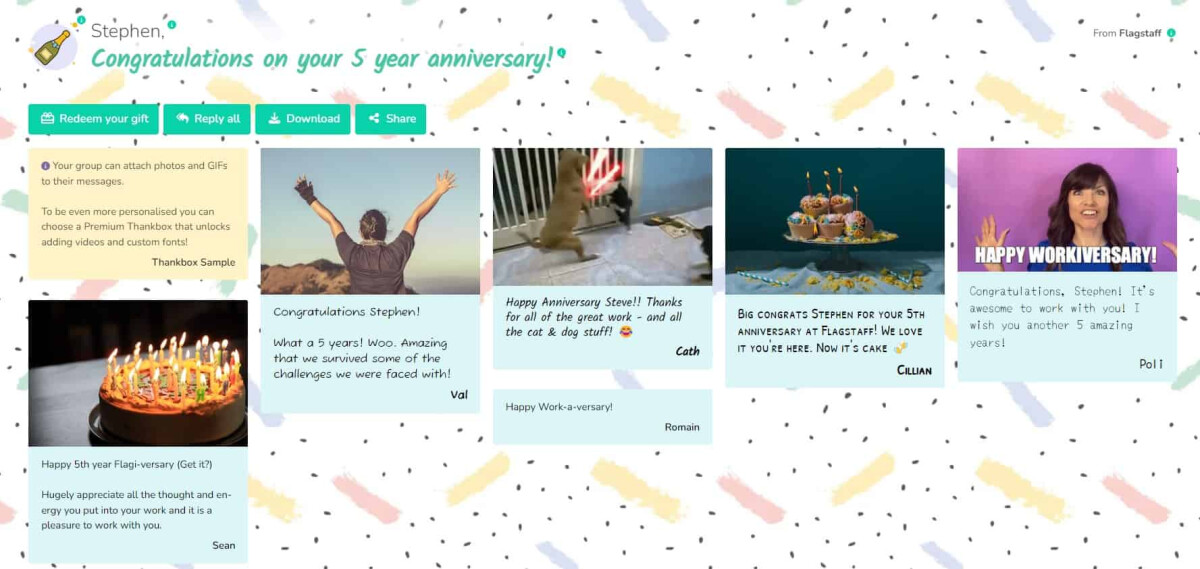Enhancing Your Workplace Communication Skills: 9 Effective Strategies


Have you ever found yourself mid-conversation, realising that your colleague is more interested in their coffee than your words? It’s a tad frustrating, isn’t it? In our buzzing workplaces, ensuring our messages don’t vanish into thin air is practically an art form.
Thankfully, you don’t need to be a master communicator to get your voice heard. With a few tweaks, you can easily bridge the communication gap. Whether you’re the team’s chatterbox or the quiet genius by the printer, we’ve got some golden nuggets that’ll make your communication shine.
Ready to dive in? In this article from Thankbox, we’re highlighting nine strategies to help you communicate like a pro. So, if you’re curious about amping up your communication game, keep reading!
What is effective workplace communication?
Workplace communication isn’t just about passing along messages or chit-chatting by the water cooler. It’s the process of exchanging ideas, project updates, and feedback at work. Without effective communication, you could face mix-ups or misunderstandings.
Communication in the office spans team meetings, emails, and video conferencing. Whether in a real-time meeting or sending virtual updates, it’s all about ensuring the sender and receiver are on the same page. Workplace communication is purpose-driven and requires a tad more formality (though a good meme or GIF can lighten the mood!).
Our virtual greeting cards facilitate meaningful connections in a world where communication can sometimes feel shallow. Boost your professional relationships, enhance personal bonds, and leave a lasting impression with the help of Thankbox.
Benefits of effective workplace communication
Whether you’re liaising with clients or collaborating with team members, building rapport is often a key aspect of most job roles. And with nearly half of workers reporting that poor communication negatively impacts productivity, supercharging your conversational talents is a must!

Let’s explore some of these benefits:
Elevate staff involvement and sense of community
Foster team commitment and support
Enhance work output and efficiency
Cultivate a healthy work-life balance
Minimise disagreements and disputes
Strengthen staff loyalty through crystal-clear interactions
As we underscore the importance of effective communication, Thankbox is an innovative tool that stands out. This platform allows teams to send online group greeting cards containing personalised messages, GIFs, photos, and videos. Perfect for commemorating work anniversaries or simply connecting over a Nicolas Cage GIF.

Better yet, Thankbox underscores a commitment to sustainability with every e-card sent, making it an eco-friendly initiative. In essence – tools like Thankbox amplify the benefits of solid workplace communication, offering both tangible and intangible advantages.
9 tips for top-notch communication in the workplace
1. Keep it real
In the workplace, it’s easy to get lost in a sea of buzzwords and industry-specific language. To ensure your message is understood, avoid jargon or overly technical terms, especially when speaking to individuals outside your immediate team.
Additionally, if something is unclear, don’t hesitate to request elaboration or different phrasing. By posing questions you demonstrate active engagement while conveying a genuine desire to understand their viewpoint.
2. Listen more, talk less

To ensure you’re on the same wavelength with your team, employ active listening techniques. These include nodding to acknowledge a statement, verbal affirmations, and focusing on genuinely understanding the speaker instead of planning your response.
3. Choose your communication method wisely
Before diving into a conversation, pause and reflect and ask yourself what’s your objective, who’s your target audience, and how best to convey your message. Miscommunication often arises when the wrong message reaches the wrong audience.
Consider the preferred communication style of each individual. Some might favour emails, and others might value in-person conversations. As a rule of thumb – urgent announcements and sensitive matters should ideally be communicated in person if you work in-office.
4. Drive conversations by asking questions
Taking the initiative to pose relevant questions builds rapport and showcases your genuine engagement. Being the one to inquire can also allow you to guide the conversation effectively, ensuring that it stays productive. To get an in-depth understanding, employ the classic 5 Ws:
What’s the situation?
Who are the key players?
When did it transpire?
Where was the scene?
Why did it happen?
5. Celebrate individual communication styles

Enhancing workplace communication hinges on recognising and valuing each employee’s distinct approach to interaction. This involves understanding their favoured communication styles and adapting accordingly.
For instance, while the marketing team may engage best with success stories and case studies, the IT department might prefer straightforward specifications and technical details.
6. Invest in positivity
A constructive work setting encourages open dialogue and eases tension. When organising a meeting, prioritise an unbiased setup. Position seating so no one feels marginalised, ensuring an environment where everyone feels at ease sharing their thoughts.
Consider implementing a pre-meeting icebreaker activity to help attendees relax and feel more connected, paving the way for an open and effective group discussion.
Our virtual greeting cards facilitate meaningful connections in a world where communication can sometimes feel shallow. Boost your professional relationships, enhance personal bonds, and leave a lasting impression with the help of Thankbox.
7. Don’t shy away from silence
Don’t shy away from occasional silences during discussions with clients or colleagues. These quiet intervals provide opportunities for reflection, allowing both parties to absorb information and articulate their thoughts more effectively. If you’re uncomfortable with silence, challenge yourself to embrace it – the results might surprise you.
8. Be brief, be bright, be gone

Getting straight to the point without sacrificing essential details can enhance the impact of your message. The mantra “Be Brief, Be Bright, Be Gone” captures the essence of effective communication. So, present your ideas clearly, ensure they resonate, and then step back, allowing room for feedback and reflection.
9. Mind your non-verbal cues
Effective communication goes beyond words – it’s also reflected in your body language and tone. To avoid misunderstandings, steer clear of unintentional signals like crossed arms or an abrupt tone. Even if unrelated stressors affect you, strive for neutral body language, especially during challenging discussions.
Wrapping up
By adopting these strategies, you’ll not only improve understanding but also promote efficiency and teamwork. After all, every interaction offers an opportunity to connect, understand, and work together.
As you integrate these communication tips, why not take your efforts a step further with Thankbox? This unique platform offers an innovative way to connect and convey messages in a personalised and memorable manner. Create your Thankbox today and let your communication shine.
Images: Cover | People working together | A man listening to a paper cup phone | A man and a woman sitting at a table and smiling | Colleagues sitting at a table and listening to each other





